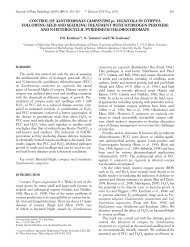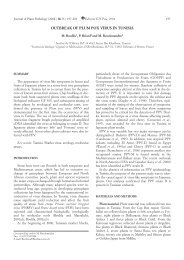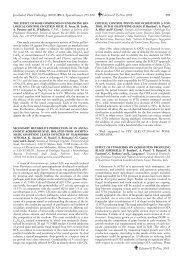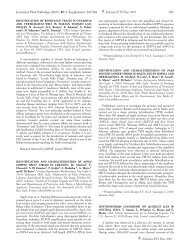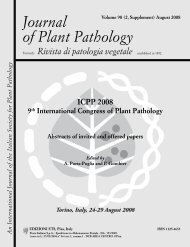Journal of Plant Pathology (2010), 92 (4, Supplement ... - Sipav.org
Journal of Plant Pathology (2010), 92 (4, Supplement ... - Sipav.org
Journal of Plant Pathology (2010), 92 (4, Supplement ... - Sipav.org
Create successful ePaper yourself
Turn your PDF publications into a flip-book with our unique Google optimized e-Paper software.
<strong>Journal</strong> <strong>of</strong> <strong>Plant</strong> <strong>Pathology</strong> (<strong>2010</strong>), <strong>92</strong> (4, <strong>Supplement</strong>), S4.71-S4.105 S4.81<br />
primary inoculum for transmission mechanical means or by Bumble<br />
bees. How PepMV infection initiates in new areas is now understood,<br />
but tomato seed has been suspected as one <strong>of</strong> the key<br />
components <strong>of</strong> worldwide epidemics. The objective <strong>of</strong> this study<br />
was to investigate the role <strong>of</strong> PepMV transmission by Bumble<br />
bees. Observations were carried out in different farms in Ragusa<br />
province. The tomato genotypes were Genio and Shereen (severe<br />
symptoms on the fruits), Piccadilly (mild symptoms) and Belize<br />
(symptomless) In some farms 70 Bumble bees were used per<br />
1,000 mq (thesis A), while in others 140 or more (thesis B). At<br />
the beginning <strong>of</strong> the observations 10% <strong>of</strong> plants were infected.<br />
By the end <strong>of</strong> March, 30% <strong>of</strong> plants were infected in the farms A,<br />
while in B the infection rate was between 60 and 90%. The cultivation<br />
procedures and transplant dates were practically identical<br />
in all farms. On the basis <strong>of</strong> our observations we can affirm that a<br />
high number <strong>of</strong> Bumble bees significantly contributed to the<br />
spread <strong>of</strong> PepMV.<br />
INHIBITORY EFFECT OF FURFURALS CONTAINED IN<br />
THE STEAM-EXPLODED BIOMASS OF MISCANTHUS<br />
SINENSIS AGAINST SOIL-BORNE PLANT PATHOGENS.<br />
U. De Corato 1 , N. Sharma 2 , O. Maccioni 2 , F. Zimbardi 3 . 1 Agenzia<br />
Nazionale per le Nuove Tecnologie, l’Energia e lo Sviluppo Economico<br />
Sostenibile (ENEA), Unità Tecnica Efficienza Energetica,<br />
Servizio Agricoltura, Centro di Consulenza Energetica Integrata di<br />
Bari, Via Roberto Da Bari 119, 70122 Bari, Italy. 2 Laboratorio di<br />
Biotecnologie dell’ENEA, Centro Ricerche Trisaia, S.S. 106 Jonica<br />
Km. 419.500, 75026 Rotondella (MT), Italy. 3 Laboratorio di Biomasse<br />
e Solare Termico dell’ENEA, Centro Ricerche Trisaia, S.S.<br />
106 Jonica Km. 419.500, 75026 Rotondella (MT), Italy. E-mail:<br />
ugo.decorato@enea.it<br />
The Steam-Exploded Biomass (SEB) <strong>of</strong> Miscanthus sinensis, a<br />
herbaceous perennial species growing up to 3-4 m in height, with<br />
an annual yield <strong>of</strong> 20-25 tons/ha, is a good renewable energy resource.<br />
SEB could also be useful in crop protection, as an alternative<br />
to the use <strong>of</strong> compost in the greenhouse against soil-borne<br />
plant pathogens. Detailed studies on disease suppressiveness <strong>of</strong><br />
SEB yielded positive results against three pathosystems. In this<br />
work, we studied the inhibitory effect <strong>of</strong> furfurals contained in<br />
the SEB against Phytophthora nicotianae, Pythium ultimum,<br />
Fusarium oxysporum f. sp. lactucae, Fusarium oxysporum f. sp.<br />
melonis and Rhizoctonia solani. Analysis <strong>of</strong> microbial growth inhibitors<br />
was carried out by HPLC, and inhibition <strong>of</strong> furfurals was<br />
tested in vitro. Furfural, 5–HMF, lignosulfonates, acetic and<br />
formic acid were detected at a concentration <strong>of</strong> 2.93, 0.28, 4.12,<br />
10.07, 1.88 g/l, respectively. P. ultimum, P. nicotianae and R.<br />
solani were inhibited by the addition to PDA <strong>of</strong> 3.2 g/l furfural<br />
and 0.48 g/l 5–HMF. However, both furfurals were not efficient<br />
inhibitors <strong>of</strong> F. oxysporum f. sp. lactucae and melonis at the same<br />
concentrations. An increase <strong>of</strong> furfural and 5–HMF concentration<br />
in the growing medium correlated positively with inhibition<br />
<strong>of</strong> P. ultimum, P. nicotianae and R. solani, but not with the growth<br />
<strong>of</strong> F. oxysporum. Disease suppressiveness <strong>of</strong> SEB could be related<br />
to its content <strong>of</strong> furfurals, <strong>org</strong>anic acids and lignosulfonates produced<br />
during processing <strong>of</strong> fresh biomass in a pilot plant <strong>of</strong><br />
Steam-Explosion.<br />
THE INFLUENCE OF YEAST ORIGIN AND IDENTITY<br />
ON MODES OF BIODEGRADATION OF PATULIN BY<br />
BASIDIOMYCETOUS PINK YEASTS. F. De Curtis 1 , R.<br />
Quici 1 , G. Ianiri 1 , L. Palmgren 2 , V. De Cicco 1 , R. Castoria 1 ,<br />
S.A.I. Wright 1,2 . Dipartimento di Scienze Animali, Vegetali e del-<br />
l’Ambiente, Università del Molise, Via F. De Sanctis, 86100 Campobasso,<br />
Italy. 2 Department <strong>of</strong> <strong>Plant</strong> and Environmental Sciences,<br />
University <strong>of</strong> Gothenburg, Göteb<strong>org</strong>, Sweden. E-mail: decurtis<br />
@unimol.it<br />
Pink yeasts belonging to the genera Sporobolomyces/Sporodiobolus,<br />
Rhodosporidium/Rhodotorula, Cyst<strong>of</strong>ilobasidium/Cryptococcus<br />
and Erythrobasidium are natural inhabitants <strong>of</strong> many agricultural<br />
and wild plant species. Their natural role in the microbial<br />
ecology <strong>of</strong> the phylloplane is not sufficiently understood.<br />
When isolated and purified, many are able to suppress plant diseases<br />
and some can biodegrade patulin. Pink yeasts were isolated<br />
from the phyllosphere <strong>of</strong> agricultural and wild plants in various<br />
climatic zones, islands, coastal, hilly and mountainous regions <strong>of</strong><br />
south-central Italy. Yeasts were purified and characterized by<br />
morphological and molecular methods. Subsequently, they were<br />
tested for the ability to degrade patulin, a mycotoxin produced<br />
by Penicillium expansum, the causal agent <strong>of</strong> blue mould. The<br />
highest degree <strong>of</strong> yeast biodiversity was recorded in the Tremiti<br />
islands, because more species <strong>of</strong> plants were sampled and because<br />
<strong>of</strong> the absence <strong>of</strong> intense agricultural activity. Most <strong>of</strong> the<br />
170 pink yeasts isolated belonged to the genus Rhodosporidium.<br />
More yeasts were isolated from apple and fig trees than from<br />
olive in three comparable locations. Fig trees had a more diverse<br />
epiphytic micr<strong>of</strong>lora than did apple and olive. Interestingly, apples<br />
appear to host predominantly two different types <strong>of</strong> pink<br />
yeasts, as shown by analysis <strong>of</strong> morphological traits, RFLP (restriction<br />
fragment length polymorphism) and sequencing <strong>of</strong> the<br />
ITS (internal transcribed spacer) regions. We have evidence suggesting<br />
that members <strong>of</strong> specific phylogenetic groups are capable<br />
<strong>of</strong> degrading patulin. No isolates from wild plants were able to<br />
biodegrade patulin.<br />
CHARACTERIZATION OF RESISTANCE TO QOI FUNGI-<br />
CIDES IN BOTRYOTINIA FUCKELIANA (BOTRYTIS<br />
CINEREA). R.M. De Miccolis Angelini, C. Rotolo, S. Pollastro,<br />
A. Santomauro, M. Masiello, F. Faretra. Dipartimento di Protezione<br />
delle Piante e Microbiologia Applicata, Università degli<br />
Studi “Aldo Moro”, Via Amendola 165/A, 70126 Bari, Italy.<br />
E-mail: faretra@agr.uniba.it<br />
Botryotinia fuckeliana (Botrytis cinerea), the grey mould fungus,<br />
is well known for its adaptability to adverse conditions that<br />
frequently lead to acquired resistance to fungicides. QoIs include<br />
fungicides effective against a broad spectrum <strong>of</strong> fungi. They act<br />
as mitochondrial respiration inhibitors at the cytochrome bc 1 -<br />
complex level and are considered at high risk <strong>of</strong> acquired resistance.<br />
The response <strong>of</strong> B. fuckeliana field isolates, collected prevalently<br />
from grapevine in Italy, France, Germany and Japan, to<br />
several QoI fungicides was evaluated by colony-growth and conidial-germination<br />
assays. Media were amended with various concentrations<br />
<strong>of</strong> QoIs along with salicylhydroxamic acid, a specific<br />
inhibitor <strong>of</strong> alternative oxidase. Tested fungicides showed different<br />
effectiveness against B. fuckeliana. Positive cross resistance<br />
between QoI fungicides belonging to different chemical groups<br />
was observed. One-hundred-thirty-four isolates were characterized,<br />
35 <strong>of</strong> which showed a high level <strong>of</strong> resistance (RF ≥ 200).<br />
All isolates carried the G143A mutation in the mithocondrial cytochrome<br />
b (cytb) gene, as shown by CAPS (Cleaved Amplified<br />
Polymorphic Sequences) analysis with the AluI enzyme. Classical<br />
genetic analysis confirmed that QoI-resistance is maternally inherited<br />
by ascospore progeny <strong>of</strong> sexual crosses. The polymorphic<br />
structure <strong>of</strong> the cytb gene <strong>of</strong> B. fuckeliana was investigated in 52<br />
sensitive and 47 resistant isolates. A 1.197-bp intron (group I)<br />
was detected, flanking downstream codon 143 <strong>of</strong> the gene exclu-



